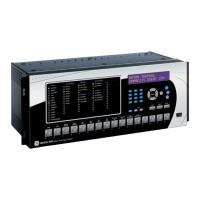5-152 M60 Motor Protection System GE Multilin
5.6 GROUPED ELEMENTS 5 SETTINGS
5
where: TCU
end
= THERMAL CAPACITY USED if I
equivalent
remains steady state
I
eq
= I
equivalent
motor heating current
hot / cold = HOT/COLD SAFE STALL RATIO setting
• RTD BIAS: This setting enables or disables the RTD bias mechanism. See the RTD BIAS MINIMUM, RTD BIAS CENTER,
and RTD BIAS MAXIMUM setting descriptions below for details on using the RTD bias mechanism.
The RTD Bias feature is active only if the optional RTD Input module (module 5C or 5E) has been
installed.
• RTD BIAS MINIMUM / CENTER / MAXIMUM: The relay thermal replica operates as a complete and independent
model. The thermal overload curves however, are based solely on measured current, assuming a normal 40°C ambi-
ent and normal motor cooling. If there is an unusually high ambient temperature, or if motor cooling is blocked, motor
temperature will increase. If the motor stator has embedded RTDs, the RTD bias feature should be used to augment
the thermal model calculation of Thermal Capacity Used.
The RTD bias feature is a two-part curve (RTD Bias Thermal Capacity Used) constructed from three points: minimum,
center and maximum. If the maximum stator RTD temperature is below the
RTD BIAS MINIMUM setting (typically 40°C),
no biasing occurs. If the maximum stator RTD temperature is above the RTD BIAS MAXIMUM setting (typically at the sta-
tor insulation rating or slightly higher), then the thermal memory is fully biased and RTD bias thermal capacity used is
forced to 100%. At values in between, the present RTD bias thermal capacity used created by other features of the
thermal model is compared to the RTD bias thermal capacity used. If the value of the RTD bias thermal capacity used
is higher, then this value is used from that point onward. The
RTD BIAS CENTER setting should be selected to the rated
running temperature of the motor. The relay will automatically determine the RTD bias thermal capacity used value for
the center point using the HOT/COLD SAFE STALL RATIO setting.
(EQ 5.17)
At < RTD_Bias_Center temperature,
(EQ 5.18)
At > RTD_Bias_Center temperature,
(EQ 5.19)
where: RTD_Bias_TCU = thermal capacity used due to hottest stator RTD
Tem p
acutal
= current temperature of the hottest stator RTD
Tem p
min
= RTD Bias minimum setting
Tem p
center
= RTD Bias center setting
Tem p
max
= RTD Bias maximum setting
TCU at RTD_Bias_Center = thermal capacity used defined by the
HOT/COLD SAFE STALL RATIO setting
In simple terms, the RTD bias feature is feedback of measured stator temperature. This feedback acts to correct the
assumed thermal model. Since RTDs have a relatively slow response, RTD biasing is useful for slow motor heating.
Other portions of the thermal model are required during starting and heavy overload conditions when motor heating is
relatively fast.
It should be noted that the RTD bias feature alone cannot create a trip. Even if the RTD bias feature forces the RTD
bias thermal capacity used to 100%, the load current must be above the overload pickup setting to set the output.
Do not program
RTD BIAS MAXIMUM setpoint greater than 200°C if using a remote RTD unit, since the RRTD
only measures temperatures up to 200°C.
TCU at RTD_Bias_Center 1
hot
cold
-----------
–
100%=
RTD_Bias_TCU
Temp
actual
Temp
min
–
Temp
center
Temp
min
–
--------------------------------------------------------
TCU at RTD_Bias_Center=
RTD_Bias_TCU
Temp
actual
Temp
center
–
Temp
max
Temp
center
–
-------------------------------------------------------------
100 TCU at RTD_Bias_Center– TCU at RTD_Bias_Center+=

